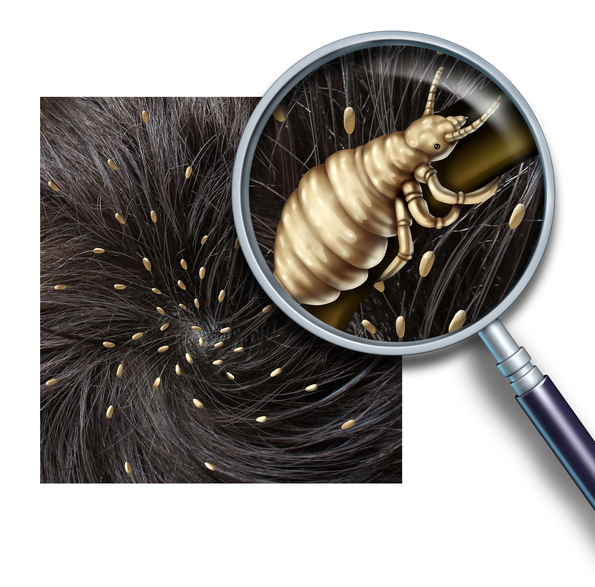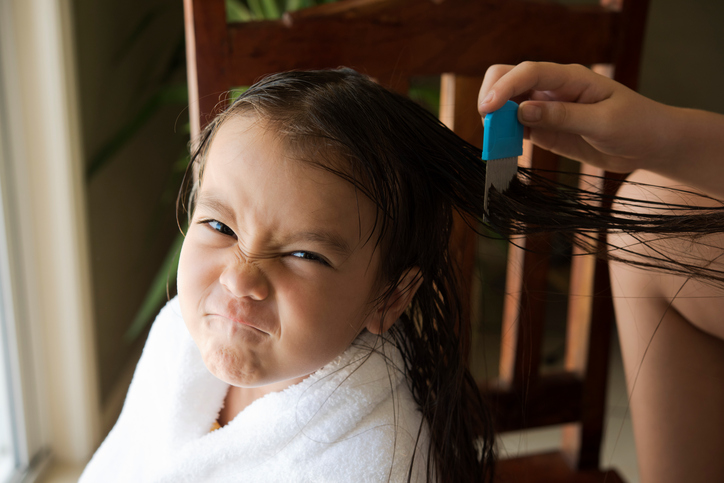- solen.sk - article about viral hepatitis A - in pdf
Parasites, lice or other diseases in our schools and nurseries?

The beginning of the school year is behind us, and young preschoolers and schoolchildren have to get used not only to the school regime or school duties. Their organism and immunity have to deal with various diseases that often occur in children's groups.
Article content
Proper and sufficient hygiene is the basis for prevention against communicable diseases. Therefore, hygiene habits are observed from a young age.
Up to 80 % of infections are transmitted by dirty hands, for example hepatitis A, salmonellosis and respiratory diseases.
Parasites in children
Diseases caused by parasites are relatively common in children's groups and institutions. Diseases caused by animal parasites are called epizootic diseases. Their occurrence is influenced by hygiene, social conditions and collective living.
Pediculosis - lice
Pediculosis is considered to be an infectious disease caused by childhood lice. It mainly affects children, but can occur in all age and social groups.
This parasite lives most often in the hair, but can also occur in the eyebrows, chin or beard. It is also known by the names hair louse or head louse (Pediculus capit).
In addition, there is also the clothes louse (Pediculus corporis), which is a carrier of some serious infections. However, the latter is not so common.
We also know of the pubic louse (Phthirus pubis), which attaches to the hairs of the genital area, armpits or chest.
The louse is a parasite that can only parasitize humans. They do not accept blood other than human blood.
The baby louse lives for about 30 days, during which time it can lay 100 to 140 eggs. This parasite does not fly or jump, but spreads by close contact. However, it can swim, so you can get infected at the swimming pool.
They are spread mainly in children's groups, nurseries and schools. Transmission is often through objects such as combs, towels or, for example, sleeping together.

The eggs of the lice are called nits. The females lay them and attach them to the roots of the hair with a firm sealant. Three to four eggs are laid daily. The white, later yellow-white to brown eggs hatch into larvae. The male lice are 2 to 3 millimetres in size, the female 3 to 3.5.
The mouthparts of both larvae and adult lice are adapted to sting and suck the blood they feed on. When stung, the lice release a secretion into the skin that causes unpleasant itching. The subsequent scratching creates the risk of purulent inflammation and the introduction of bacteria into the damaged skin.
The occurrence of lice and their spread is most common in places where people are in close contact with each other. These are schools, kindergartens, dormitories, camps and so on.
Lice are not able to survive on hair that is less than one centimetre long.
The typical symptoms of pediculosis, i.e. lice infestation, are persistent itching and scratching of the hairy part of the head. Visually, i.e. with the naked eye, adult crawling lice or eggs, i.e. nits, can be found on the head. They are most often found in the nape of the neck and in the area behind the ears.
Some sources report that the prevalence of head lice has been increasing over the last ten years, mainly because de-worming products are losing their effectiveness and lice are becoming more resistant.
What about the school, its obligations and legislation
Everything that needs to be done in the event of a communicable parasitic disease or other acute illness in a child should be included in the school's operating rules. When lice are present in the school or other school settings, it is their responsibility to inform all parents of children attending the school.

When lice or other parasites are suspected, the school administration and the child's parent or guardian should be notified. The child must be isolated from other children with temporary supervision.
Care must be taken to ensure that outer clothing is kept away from the clothing and belongings of other pupils. This is particularly true of items of clothing that come into contact with the hair and head, such as scarves or hats. Items such as combs must also be kept away from the belongings of other children.
The parent will be advised to visit the child's general practitioner to confirm the diagnosis of scabies and the next course of action.
Bed and personal linen should be washed at high temperatures and carefully dried and ironed.
Items that have come into contact with the scalp, such as combs, hair ornaments, hairpins, should be sprayed with an insecticide for crawling insects, mattresses and mattress pads should be aired, exposed to sunlight and not used for at least 3-4 days.
Ideally, the disinsection should be carried out at the same time for all children in the collective, even those who have not been disinfected. It is advisable to repeat the disinsection after 8-14 days for a reliable effect.
The school should inform other parents of the presence of head lice in the school premises. It should also encourage parents to cooperate in the daily preventive checking of their children's hair before going to school or kindergarten.
Parental responsibility
Paediculosis is a disease that also requires health care. The parent is responsible for the child's health and for making health care possible. If this care is neglected, it can be considered a breach of the duty of care. It is also a violation of fundamental rights, and the solution falls within the domain of social institutions.
The parent is responsible for:
- compliance with family hygiene rules
- changing personal and bed linen regularly
- washing laundry at high temperatures
- washing and disinfecting hats, scarves, combs and shawls
- checking the child's hair regularly
- if lice are present, do not bring the child to school and inform the school immediately for preventive measures to be taken at the school
- if suspected, see a doctor to confirm or rule out the presence of pediculosis and to determine further action
Prevention of pediculosis
The most effective measure to prevent the spread of lice is to check children's hair daily. If lice are found, treat immediately with lice shampoo.
The most effective way to prevent recurrence of pediculosis is to carry out disinsection at the same time not only for all children in the school but also for family members.
If suspected, a child may be admitted to the facility only after presentation of a doctor's note.
The most serious problem and complication is that families from lower socio-economic backgrounds often do not take effective treatment measures because disinsecticides are not covered by health insurance.
Lice removal procedure
Lice can be conclusively confirmed or refuted by using a thick comb. The hair should be combed from the roots over a light pad for at least five minutes.
Frequent washing of the hair, although it partially prevents the parasites from multiplying, is considered to be an inadequate method. To remove them, use products designed for this purpose and follow the instructions. After shampooing with an anti-lice shampoo, the hair should be rinsed, dried and combed through with a thick comb designed for this purpose. This will remove all dead lice and nits from the hair.

Hats, scarves or shawls should be boiled or washed at high temperatures if possible, dried, exposed to sunlight, or thoroughly ironed and sprayed with a crawling insect repellent. Similarly, items such as bedding, mattresses and the like should be treated.
At present, there is no product on the market that can effectively remove the eggs, i.e. nits. The products available on the market do not penetrate the germs that are hidden in the nits. This is for reasons of safety with regard to the child's skin. The only option is to remove the nits by hand, hair by hair, and comb them out. As a preventive measure, so-called repellent products can be used against everything.
The development cycle of child lice:
| The egg | 6-9 days | yellow-white, translucent after hatching |
| larva | 2-4 days | translucent in colour |
| adult female | 2-3 weeks | changes colour to dark reddish-brown after blood-sucking |
Animal-borne parasites
Outdoor playgrounds, climbing frames and sandpits are also part of schools and nurseries. Parasites such as toadstool, which causes enterobiosis, or nematodes, which cause ascariasis, can be present in an improperly maintained sandpit. Toxoplasmosis is known to be carried mainly by cats.
These parasites enter the body most often from animal faeces, through the child's dirty hands. Most of the animals involved are cats, dogs or birds. They cause digestive problems such as abdominal pain or vomiting, but also skin rashes or itching of the anus.
The operator should have maintained a certain cleanliness and prevented the sand from exceeding a certain amount of microbial and parasitic contamination.
Read more about the diseases and obligations of sand pit operators in the article:Children's sandboxes as a potential health risk
Diseases associated with skin manifestations
Communicable diseases, which manifest themselves as rashes or other symptoms of irritated skin, can be of various types. However, skin manifestations often occur after the initial non-specific symptoms.
Spála
Scarlet fever is an infectious disease that initially manifests itself as tonsillitis, which is why it is also known as scarlet fever. It is caused by the streptococcus bacterium, which produces a toxin that causes fever and damages the fine blood vessels under the skin. This produces the typical scarlet fever rash. It first appears in the lower abdomen and chest and then spreads to the extremities.
However, the initial symptoms are headache, vomiting, fever and, as in tonsillitis, swelling of the tonsils in the throat, which are covered with pins and needles and a purulent coating. The typical symptom is a white coated tongue at first, which later peels off to form a bright red, so-called raspberry tongue.
It is common in groups, as it is transmitted by droplet infection. It is therefore spread through the air by sneezing or coughing. Treatment consists mainly of antibiotics.
You can read more in the article on scarlet fever.
Chickenpox
Chickenpox is also a highly infectious disease spread by droplets. The disease is caused by the Vaaricella zoster virus. Symptoms include a high temperature, fever, chills or malaise. The most typical symptoms are rashes and blisters all over the body that itch unpleasantly.
As this is a viral disease, treatment with antibiotics is pointless. Therapy is given to relieve the accompanying symptoms and topical treatment of the rashes with liquid powder or antiseptic ointment. These cause the rashes to dry better, prevent further infections and relieve the itching. After experiencing the disease, the body develops a lifelong immunity to the disease.
Read more in the article on chickenpox
Measles
Another of the infectious diseases transmitted by the droplet route. The disease begins with non-specific symptoms such as increased temperature, fever. Later, reddened conjunctivae, dry irritating cough and typical skin rashes in the form of small spots appear.
The seriousness of the disease lies in its potentially dangerous complications, such as pneumonia and central nervous system disorders. However, the incidence of measles has fallen significantly under the measles vaccination programme.
Treatment is symptomatic, i.e. it focuses on the accompanying symptoms and complications of the disease.
Read also the article Measles and the magazine article Measles or chickenpox?
Diseases of the digestive system
The most common diseases are those caused by viruses. The bacterial origin is mainly encountered with bacteria such as salmonella, shigella, campylobacter, staphylococcus, clostridia, or pathogenic E coli.
The entry point of infection is most often the mouth, through contaminated water or food.
Viral diseases often have a rapid onset, but with proper treatment, the child's condition improves rapidly. Bacterial diseases tend to be more gradual, but with a more severe course. Antibiotic treatment is often necessary.
The course of diseases affecting the digestive system is often accompanied by diarrhoea and vomiting. It is therefore important to ensure sufficient fluid intake and avoid dehydration of the body. If it is not possible to administer sufficient fluids naturally, it is necessary to provide infusion therapy.
Hepatitis A
This is a viral inflammatory disease of the liver caused by the hepatitis A virus. This infectious disease can occur in socially deprived populations with lower standards of hygiene. A child can become infected through contaminated hands, water or food. The source of infection is the person who excretes the virus through faeces.
Initial symptoms are also non-specific, such as temperature, headache, vomiting or diarrhoea. Icterus is typical - yellow discolouration of the skin and whites of the eyes. Urine is dark, while stools are lighter.
The most effective prevention is hygiene. Another effective prevention is vaccination, but this is not compulsory. However, it is recommended especially for children in socially deprived areas, especially before entering a collective, such as schools or kindergartens.
Treatment depends on the course of the disease. In most cases, bed rest and avoidance of fatty and greasy foods are sufficient. In the early days, an increase in the intake of a diet rich in sugars is recommended, or glucocorticoids - drugs that reduce the inflammatory reaction - may be given.
Read also the magazine article.
Morning filter
Pre-school operators should ensure that only children who do not show signs of communicable disease are admitted to the pre-school. To this end, a so-called morning filter is carried out, in which the person in charge checks the health of the children on arrival at the facility.

If signs of communicable disease appear during the day, it is the school's responsibility to ensure separation from other children with temporary supervision and to notify parents. They will then recommend a visit to a doctor to confirm or rule out the disease.
Infections of the mucous membranes of the upper respiratory tract, associated with a runny nose and cough, are most common in children. The causative agents tend to be viruses or bacteria spread by droplet infection, i.e. coughing or sneezing tiny droplets containing pathogenic bacteria.
The child may only return to the school after he/she has fully recovered, thus reducing the risk of infecting other children and speeding up the time for full recovery. The operator has the right to request a certificate from a competent doctor certifying the child's recovery and fitness to return to school.
Viac o pedikulóze
Interesting resources
Related










